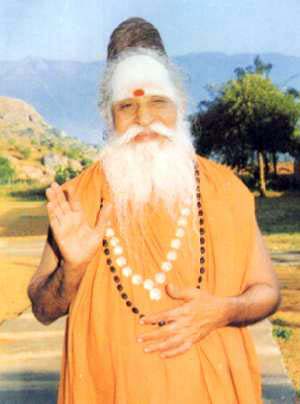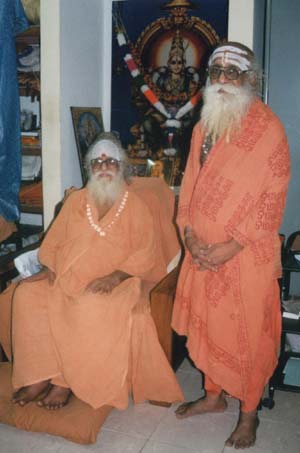
|
||||||||||||||||||
|
| ||||||||||||||||||
Śrī Santananda Swamigal of Skandasramam, Salem
His Life and Teachingsfrom the book |
![Santananda Swamigal at the feet of Śrī Bhuvaneswari [21k]](../pix/santa_03.jpg)
|
|
|
Stone walls do not prison make
Nor iron bars a cage;
Minds innocent and quiet take
That for a hermitage.
Prison became a hall of meditation for Lokamanya Tilak, Mahatma Gandhi and our Subrahmanyam. Here he studied the writings of Swami Vivekananda deeply. When he came out of the prison, he was no longer the same. This devotee of the Mother country became the devotee of the Mother Goddess. From Alipur he went direct to Madurai. He prayed to Goddess Meenakshi to show him the further course of action.
Then he approached Mayandi Yogi, who was extremely happy that notwithstanding an eventful life, Subrahmanyam did not fail to turn up when the hour arrived. He taught the youth the art of meditation and explained the monosyllabic mantra of Goddess Bhuvaneswari. He asked him to chant it unceasingly so that he could have mastery over the sense. He further advised him to remain silent and to subsist on alms and also not to stay at a place for long.
Brahmachari Subrahmanyam began his wanderings. He visited many places -- Agastya Hill, Courtalam, Tiruchendur, Tirupati, Tirunelveli, Palani, to name a few -- and did penance there. Sometimes he was mistaken for a child lifter and beaten or handed over to the police. As he kept the vow of silence, he was kept in custody for some days before he was found innocent and released.
Subrahmaniyam traveled everywhere on foot and survived on alms. He did penance at many sacred places. Then he commenced his pilgrimage to North India. He visited Badrinath, Kedarnath, Nepal and Rishikish. He stayed for some time in Rishikesh and served Swami Sivananda.
Here was an ideal disciple whom many preceptors longed to adopt. But Subrahmanyam was searching for some other type of Guru. He searched everywhere -- in forests and mountains, on river banks and in temples.
Once in the Nellaiappar Temple, Tirunelveli, When he went on dashing his head against the floor, as a part of his penance, he had the vision of an avadhuta commanding him to follow. As soon as he got up, the vision disappeared. But he often heard the echo of the command. He was Searching for only that particular avadhuta so as to become his disciple.
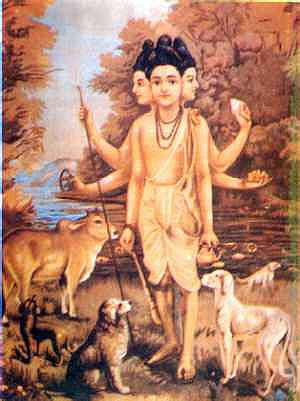 |
|
|
On the Girnar Hill, Gujarat, there is a holy place known as Śrī Datta Paduka Peetham. It is a favorite haunt of ascetics. Tradition is that only after initiation, avadhutas used to visit here. Subrahmanyam reached there even before his initiation.
It is an arduous task to climb the hill and reach its top. The place was surrounded by dense forests and was the habitat of wild animals. One had to climb hundreds of steps to reach the top. Subrahmanyam was indisposed and weak.
An unknown sadhu appeared and said. Why do you hesitate? Datta Guru is always with you. You swallow this pill and ascend the hill'. He vanished. Who was he, whence he came, and why? Nobody knew.
Subrahmanyam swallowed the pill. He felt rejuvenated and light. His mind became alert and his body strong. He climbed the hill and had the darshan of Datta paduka. He heard a voice commanding him to go to Sendamangalam (Salem district) where a Guru was waiting.
One day he reached Sendamangalam and had the darshan of Swami Swayamprakasaji. At once he realized that the avadhuta he saw in a vision at Tirunelveli was none other that Swamiji and requested that he be accepted as a disciple.
![Śrī Sadguru Swayamprakasa Brahmendra Saraswatyavadhuta Swamigal [15k]](../pix/swayamprakasha.jpg) |
|
|
Swamiji gave his consent. He admitted Subrahmanyam into the Avadhuta order and gave him a new name-- Santananda. Avadhutas were not expected to wear clothes. But the ignorant people do not understand the significance of nirvana. Therefore an exception was made in the case of Santanandaji and he was permitted to wear an ochre robe.
Next Swamiji explained the mission of Santanandaji. He told his disciple: "You have learnt the Vedas. You excel in the art of meditation. You have traveled widely and are experienced. I wish to engage you in a special work. You take charge of the Pudukkottai Adhishtanam of Judge Swamiji, my Guru. Maintain it and make it a place for pilgrimage. For one year practice the vow of silence. Subsist on alms. Stay under trees. Don't ask for anything from anyone. Ask only the spirit of Judge Swamiji to fulfill your needs. You will succeed."
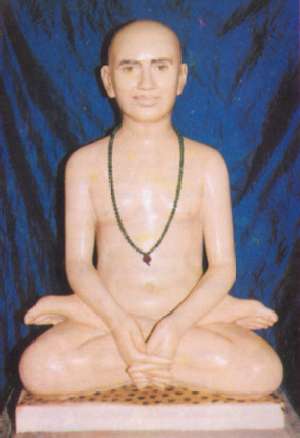 |
|
|
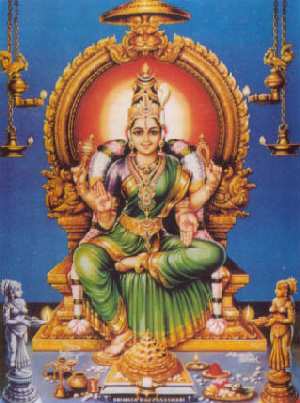
|
Santanandaji arrived at Pudukkottai. The Adhishtanam was in the midst of a grove of neem trees. There was a small tower above the tomb. Santanandaji scrupulously followed his Guru's command. He did not talk to anybody. He stayed near the Adhishtanam day and night. Whenever hungry, he simply ate the neem leaves. In sun and rain he took shelter under a tree.
Devotes started to trickle in. They were impressed by the austerity of the young Swami. They not only gave him food but also built a small room close to the Adhishtanam.
A year was over. The vow of silence too was fulfilled. Swamiji explained to the devotees the reason for his arrival and stay. Advocate Sri. P. Balasubrahmanya Sastri, the owner of the land, made deed of gift and relinquished his right over the land where the crypt existed. Then Swamiji arranged for a huge painting of Bhuvaneswari and continued his meditation in its presence.
Next, the idols of Ganapati and Karttikeya were installed on either side of Adhishtanam. Swamyamprakasa Swamiji had earlier installed a linga and an image of Santanandaji took care of his Adhishtanam also in Sendamangalam. He got the cave where his Guru lived repaired. He even went abroad to collect donations for expanding the Adhishtanam.
The most important step he took was the installation of the idol of Bhuvaneswari. None can describe the transcendental beauty of this idol. Two of Her hands carry the noose and hook and another two assure protection and give boon respectively. The divine face glows with angelic beauty and the eyes are full of compassion. The smile comforts the afflicted. She is the substance of the Gayatri mantra and the Parasakti of the Kenopanished.
Buildings grew. Devotees thronged to the Adhistanam. Houses were built. The lonely area came to be called Śrī Bhuvaneswari Nagar. In the Adhishtanam, pujas are not performed for the sake of or on behalf of individuals, but for the welfare of the world.
After the installation of the idol of the Goddess, Swamiji started a new programme of performing yagnas each year. Hundreds of devotees from far and near witness them. Swamiji has unshakable faith in yagnas. He believes that they will make India powerful and prosperous. The angels become happy whenever a yagna is performed. In the Vedas we read: Sacrifice (Yagna) is the foremost of our duties. It is the mainstay of the world. It bestows blessings on all things. It is the boat to cross the ocean and live well. Only through it the Gods attained the heaven. Through it deliverance is afforded.
In the Gita (3:10) we find the following idea: In the beginning, while creating the human beings, God instituted the sacrifice and said, "May this grant your desire like Kamadhenu and may you grow with its help."
The angels accept only the food offered in a sacrifice. When they are satisfied they send rain. As a result there will be no scarcity of water and people reap a rich harvest. This process has been mentioned in the Gita (3:14). Lord Krishna declares that I am Yagna (Gita 14:16) Scoffers of Yagnas should ponder over these ideas. Elders believe that Pudukkottai, which was an arid zone two decades ago, has become fertile because of heavy rains coaxed by these Yagnas. During the Yagnas reputed scholars of the Vedas and eminent musicians arrive at Pudukkottai and are honored and blessed by Swamiji. Every year coinciding with the Yagna, Swamiji releases a new book. In this way many spiritual works have been published for the upliftment of the people.
![Skandasramam today [13k]](../pix/skandasramam_1.jpg) |
|
|
Once Swamiji had an enchanting vision. He saw hills all around. A streamlet was flowing below. From the hills on e could see villages and green fields. Lord Skanda told Swamiji that it was there that He would like to reside.
Swamiji used to narrate this vision to devotees. One day in 1966 a devotee presented an idol of Dandayudhapani to Swamiji. But did really such a spot exist as seen in the vision?
In 1967 a devotee informed Swamiji that there did exist such a spot. With him Swamiji visited Udayapatti village which is five miles from Salem on the Athur Road. He could not believe his eyes. To the minutest detail his dream was found transformed into reality there.
The site belonged to the government which is supposed to be secular. People feared that the government would not sell the land for building a temple. Even if it agreed, it would take a long time on account of red tape to get its consent and would involve a mass of correspondence shutting between the parties. However, a petition was sent.
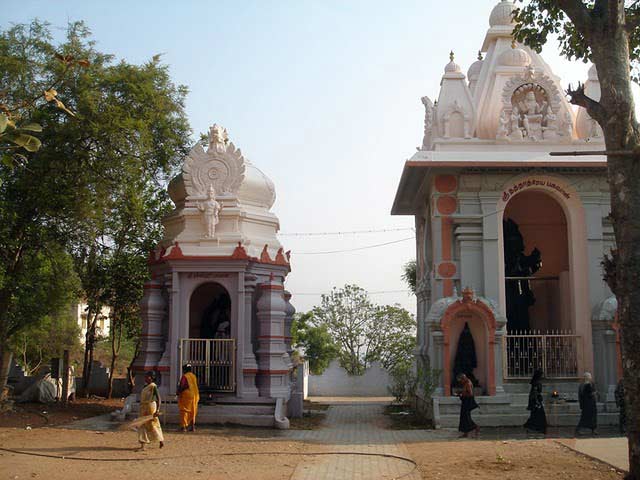
Miracles do happen even now. In a week the government issued orders handing over the land to Swamiji. That year he arranged for lighting Skanda Jyoti. The hill near Udayapatti got the name of Skandagiri. It is surrounded by three hills giving the impression that Śrī Dandapani is surrounded by Trimurtis. Coconut trees, green valleys and flowerbeds add to the scenic beauty of the place. The atmosphere is peaceful and is conductive to penance and meditation. A rivulet known as Kannimar Odai flows at the foot of the hill. There is a temple of Kanya Devi on its bank. She blesses women devotees with good husbands and conjugal happiness.
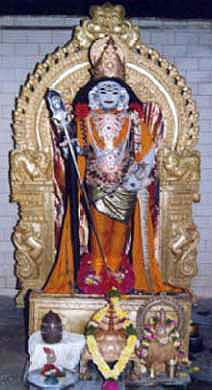
Swamiji built a beautiful temple on the hill dedicated to Lord Dandapani and Goddess Durga. A big hall for discourses and a guest house also were built. On the southern and northern sides there are temples for Vinayaka and Hidimba respectively. The main temple has a large number of idols of Vyasa, Sankara; Madhva, Ramanuja, the four great 'Nayanmars' (Saivite saints), etc. Many more idols of religious leaders are going to be added, testifying to Swamiji's synthetic approach to religion.
It is Swamiji's belief that if the Vedas are protected the world will prosper. Therefore he is conducting Yajurveda Patasalas in Pudukkottai and Skandagiri. Here students get free boarding and lodging facilities. After Swamiji, who? Swamiji is never worried about the future. He has established two trusts, one for Pudukkottai Adhishtanam and another for Skandasramam. These trusts maintain accounts meticulously and up-to date. For the dissemination of spiritual ideas and to encourage scholars of Hinduism to express their ideas, Swamiji is conducting a Tamil monthly, "Śrī Bhuvaneswari Vijayam".
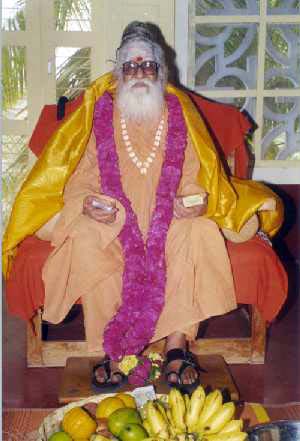 |
A glimpse of the Swamiji is enough to convince anyone of the beautiful harmony of the physical and spiritual powers both found in perfection in him. Long red, matted locks; broad forehead adorned with sacred ash and kumkum; a face glowing with peace as a result of emotional asceticism; eyes shining with a rare brightness and compassion- no wonder that our forefathers attached great importance to the darshan of saints. He performed arduous penance for many years. And yet, or perhaps as a result, his body gleams like gold. He looks neat, very clean and almost dapper. He bears himself with naturalness and at the same time with dignity. He has sweet words for everybody. His voice is like music, bringing solace to the afflicted. Pilgrims from far and near come to him for instruction, advice and consolation.
Swamiji is a scholar in Tamil and Sanskrit and a great lover of music. Wherever he goes scholars and musicians gather round him to have their doubts clarified and to be inspired by him. Propagation of the Vedic knowledge and encouragement to scholars are the twin aims that lie closest to his heart.
Swamiji spends much of his time in meditation and in chanting the holy names or mantras of Śrī Bhuvaneswari and Śrī Skandaguru. His meditation has no tinge of selfishness. It is not for nothing that his favorite deity is Śrī Bhuvaneswari- the presiding deity of the universe. He prays for the welfare of all sentient beings- 'man and bird and beast'- and he loves 'all things both great and small'. For the dear God who loveth us He made and loveth all.
For more information contact:
Om Śrī Skandasramam
Udayapatti, Salem - 636 140 India
Tel. (0427) 240660
